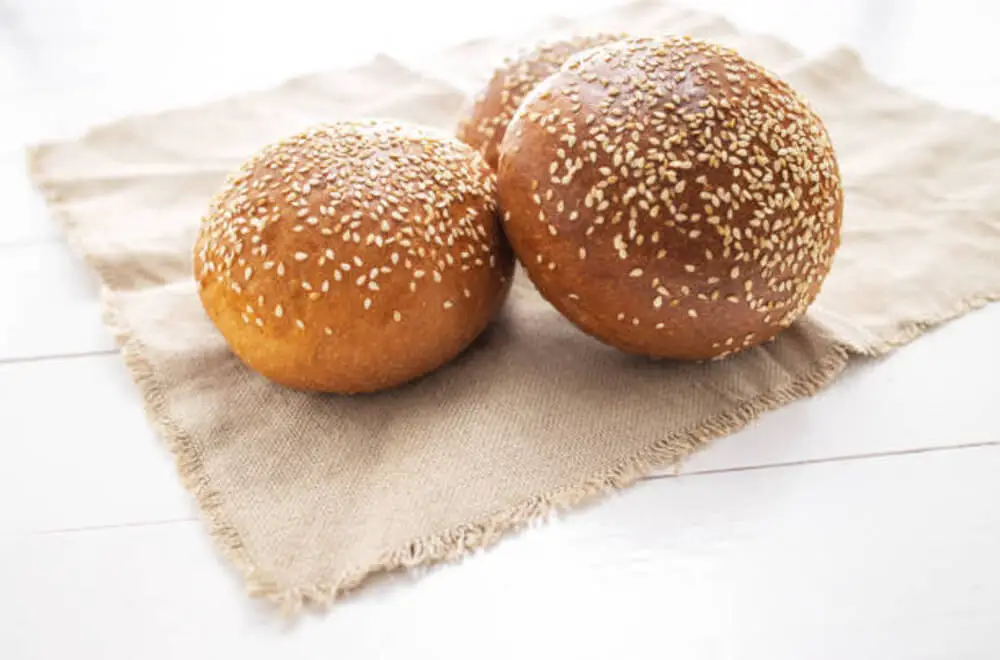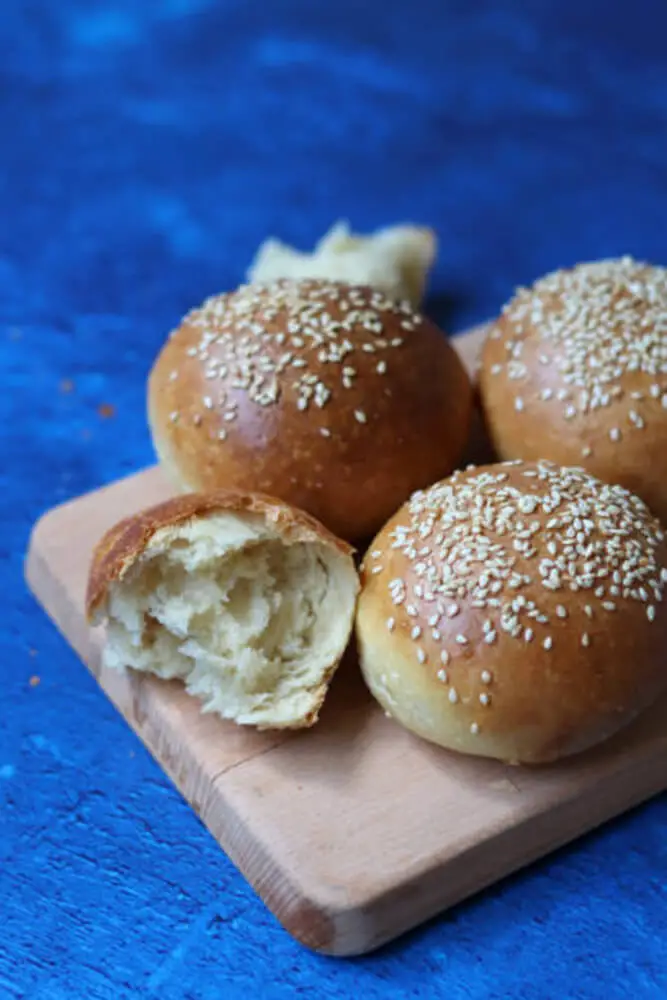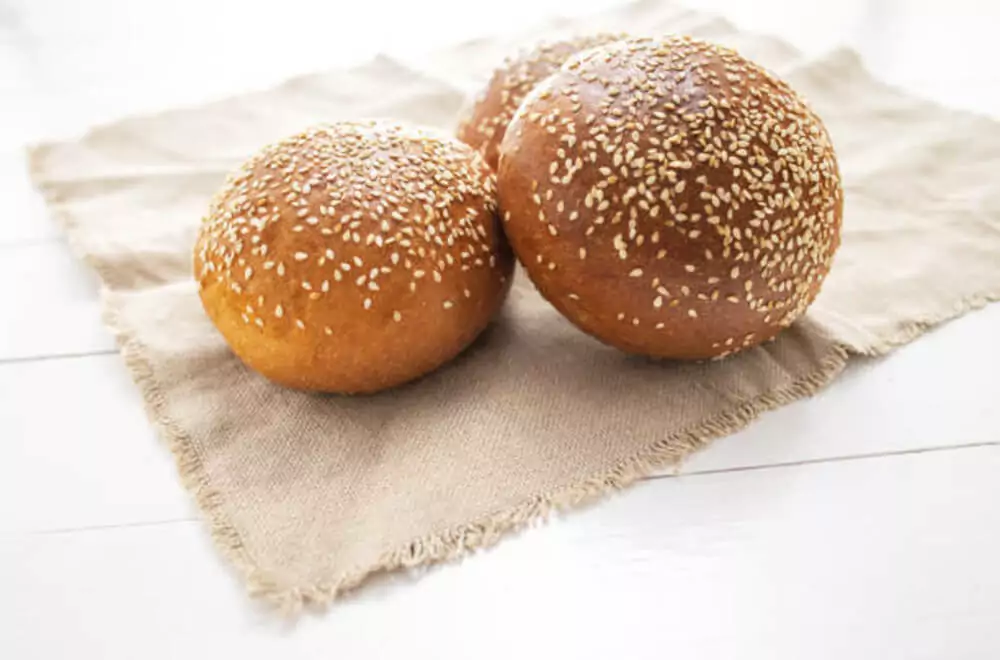Sourdough burger buns bring a delightful twist to the classic burger experience. The natural fermentation process imbues these buns with a subtle tanginess and a soft, airy texture that perfectly complements any burger filling. This recipe takes you through the journey of creating these delicious buns, highlighting the unique appeal of using sourdough starter for an elevated homemade touch.

Ingredients Breakdown
To start, you’ll need to prepare the levain, an essential component that gives these buns their characteristic flavor and texture. For the levain, you need 10 grams of ripe, active sourdough starter, 100 grams of all-purpose flour, and 100 grams of water. This mixture will ferment overnight, infusing your buns with a rich, complex taste.
The main dough requires 200 grams of the prepared levain, 240 grams of buttermilk (see recipe notes for specifics), one large egg (about 50 grams), 42 grams of sugar, 515 grams of bread flour, 11 grams of salt, and 57 grams of softened unsalted butter (approximately 4 tablespoons). These ingredients come together to create a dough that’s both flavorful and easy to work with.
For the finishing touch, you’ll need an additional large egg mixed with a splash of water for the egg wash, and your choice of toppings such as sesame seeds or everything but the bagel seasoning to add a delightful crunch and flavor.
Step-by-Step Instructions
Preparing the Levain: A Detailed Guide
To begin, mix 10 grams of active sourdough starter with 100 grams of flour and 100 grams of water. Cover this mixture and let it rest overnight, about 12 hours, until it’s bubbly, doubled in size, and has reached its peak. This fermentation process is crucial for developing the flavors that make sourdough unique.
Making the Dough
In the bowl of a stand mixer, combine the levain with buttermilk, egg, sugar, most of the bread flour, and salt. Mix these ingredients thoroughly until they are well incorporated. Gradually add the remaining flour until the dough is tacky but not overly sticky, and it pulls away from the sides of the bowl. Knead the dough for 3-5 minutes until it becomes smooth and elastic.
Next, divide the softened butter into four pieces. Add these one at a time into the dough’s center as it mixes. Continue kneading for an additional 5 minutes until the butter is fully absorbed, resulting in a smooth and glossy dough.
Bulk Fermentation Process
Place the dough in a container and set it in a warm spot for 4-5 hours. The ideal dough temperature for bulk fermentation is 78 degrees F. If your dough is cooler than this, you’ll need to extend the fermentation time; if it’s warmer, the time will be shorter. By the end of this period, the dough should have puffed up slightly (about 20%-30%) and feel smooth and airy. If it hasn’t, let it sit longer. You can also refrigerate the dough overnight or for up to 48 hours at this stage, but keep in mind that a cold ferment might require additional rise time after shaping.
Shaping the Buns
Transfer the dough to a countertop and divide it into 8 equal pieces, each roughly 130 grams. Shape each piece into a ball by pulling and pinching up the sides, then roll the ball on the counter using a cupping motion to seal and create tension, ensuring the rolls will rise properly.
Final Rise and Baking
Line a large baking sheet with parchment paper and place the dough balls on it, spaced apart. Cover and let the buns rise for 2-3 hours in a warm environment (78-80 degrees F), such as an oven with the light on. The buns are ready when they are puffed up, light, and airy. The dough should not be hard or stiff; a gentle press should leave a small indentation that springs back slightly.
Preheat the oven to 400 degrees F, ensuring the buns are removed if they were rising in the oven. Place a baking stone on the bottom rack to prevent the bottoms from burning. Mix the egg with a splash of water and brush it over the buns if desired. Sprinkle with your preferred toppings.
Place a handful of ice cubes in a baking pan and position it on the oven’s bottom rack, immediately placing the pan of buns on the rack above. Bake for 18-20 minutes until they are light brown and fully baked. Allow the buns to cool completely before toasting or using them for burgers.
Recipe Tips & Frequently Asked Questions
Pro tips for achieving the perfect sourdough buns
Ensure your levain is bubbly and at its peak before use.
Gradually add flour to control the dough’s texture.
Incorporate butter slowly for a glossy, smooth dough.
Common mistakes and how to avoid them
Overproofing the dough can lead to flat buns; monitor the rise closely.
Not kneading the dough enough can result in a dense texture.
Suggestions for alternative ingredients and variations
Substitute buttermilk with a mix of milk and vinegar or lemon juice for a tangy flavor.
Use different toppings like poppy seeds or flaky sea salt for variation.
Can I use whole wheat flour instead of bread flour?
Yes, but it will affect the texture and may require additional hydration.
How do I know if my levain is ready?
It should be bubbly, doubled in size, and have a slightly tangy aroma.
Can I skip the cold ferment step?
Yes, but the cold ferment develops deeper flavors.
What should I do if my dough isn’t rising properly?
Ensure the environment is warm enough, and give it more time. If necessary, warm the dough gently.
How can I make these buns without a stand mixer?
Mix by hand, ensuring thorough kneading to develop the dough’s structure.
What to Serve With This Recipe
Sourdough burger buns pair beautifully with a variety of burger recipes. Try classic beef patties, grilled chicken, or even veggie burgers for a delightful meal. Side dishes like crispy fries, coleslaw, or a fresh salad complement these buns perfectly. For beverages, consider a cold beer, a refreshing lemonade, or even a rich milkshake to complete your meal.
Storage and Reheating
Properly storing your sourdough buns ensures they remain fresh and delicious. Keep them in an airtight container at room temperature for up to two days. For longer storage, freeze the buns, then thaw them at room temperature when ready to use. To reheat, place the buns in a warm oven for a few minutes to restore their texture and warmth.
This sourdough burger buns recipe offers a delightful way to elevate your homemade burgers. The unique sourdough flavor and soft texture make these buns a perfect complement to any filling. We encourage you to try this recipe, share your results, and experiment with variations to make it your own. Enjoy the versatility and deliciousness of these homemade sourdough buns!

INGREDIENTS:
Levain (overnight, 10-12 hours at 78ºF)
10 grams ripe/active sourdough starter
100 grams all-purpose flour
100 grams water
Easy Sourdough Burger Buns:+
200 grams levain
240 grams buttermilk (see recipe notes)
1 large egg (about 50 grams)
42 grams sugar
515 grams bread flour
11 grams salt
57 grams unsalted butter, softened (about 4 tablespoons)
Toppings:
1 large egg (for egg wash)
A splash of water (for egg wash)
Sesame seeds or everything but the bagel seasoning (to top)
INSTRUCTIONS:
Levain (overnight/12 hours at 78 degrees F)
- Combine 10 grams of active sourdough starter with 100 grams of flour and 100 grams of water. Cover and let it rest overnight, approximately 12 hours, until it is bubbly, doubled in size, and has reached its peak.
Easy Sourdough Burger Buns
- In the bowl of a stand mixer, combine levain, buttermilk, egg, sugar, most of the bread flour, and salt. Mix thoroughly until everything is well incorporated, then gradually add the remaining flour until the dough is tacky (not overly sticky) and pulls away from the bowl’s sides. Knead for 3-5 minutes until smooth.
- Divide the softened butter into 4 pieces, adding them one at a time into the dough’s center as it mixes. Continue kneading for an additional 5 minutes until the butter is fully absorbed, and the dough is smooth and glossy.
- Place the dough in a container and set it in a warm spot for 4-5 hours. The dough temperature should be 78 degrees F during this bulk fermentation. If your dough is cooler than 78 degrees F, extend the bulk fermentation time. If it is warmer, the fermentation time will be shorter.
- By the end of the bulk fermentation, the dough should have puffed up slightly (about 20%-30%) and feel smooth and airy. If it hasn’t, allow it to sit longer. At this stage, you can refrigerate the dough overnight or for up to 48 hours. If opting for a cold ferment, additional rise time may be required after shaping.
- Transfer the dough to a countertop and divide it into 8 equal pieces, roughly 130 grams each. Shape each piece into a ball by pulling and pinching up the sides, then roll the ball on the counter using a cupping motion to seal and create tension for rising.
- Line a large baking sheet with parchment paper and place the dough balls on the sheet, spaced apart. Cover and let the buns rise for 2-3 hours in a warm environment (78-80 degrees F), such as an oven with the light on.
- The buns are ready when they are puffed up and feel light and airy. The dough should not be hard or stiff; when gently pressed, it should leave a small indentation that springs back slightly. If the dough feels firm or springs back completely, allow more time to rise.
- Preheat the oven to 400 degrees F (remove the buns if they were rising in the oven). Place a baking stone on the oven’s bottom rack to prevent the buns’ bottoms from burning.
- Mix the egg with a splash of water and brush it over the buns if desired. Sprinkle with sesame seeds or “everything but the bagel” seasoning.
- Place a handful of ice cubes in a baking pan and position it on the oven’s bottom rack, immediately placing the pan of burger buns on the rack above the ice cubes. Bake for 18-20 minutes until light brown and fully baked. Allow the buns to cool completely before toasting or using them for burgers. Enjoy!

Sourdough Burger Buns Recipe
Ingredients
Levain (overnight, 10-12 hours at 78ºF)
- 10 grams ripe/active sourdough starter
- 100 grams all-purpose flour
- 100 grams water
Easy Sourdough Burger Buns
- 200 grams levain
- 240 grams buttermilk see recipe notes
- 1 large egg about 50 grams
- 42 grams sugar
- 515 grams bread flour
- 11 grams salt
- 57 grams unsalted butter softened (about 4 tablespoons)
Toppings
- 1 large egg for egg wash
- A splash of water for egg wash
- Sesame seeds or everything but the bagel seasoning to top
Instructions
Levain (overnight/12 hours at 78 degrees F)
- Combine 10 grams of active sourdough starter with 100 grams of flour and 100 grams of water. Cover and let it rest overnight, approximately 12 hours, until it is bubbly, doubled in size, and has reached its peak.
Easy Sourdough Burger Buns
- In the bowl of a stand mixer, combine levain, buttermilk, egg, sugar, most of the bread flour, and salt. Mix thoroughly until everything is well incorporated, then gradually add the remaining flour until the dough is tacky (not overly sticky) and pulls away from the bowl’s sides. Knead for 3-5 minutes until smooth.
- Divide the softened butter into 4 pieces, adding them one at a time into the dough’s center as it mixes. Continue kneading for an additional 5 minutes until the butter is fully absorbed, and the dough is smooth and glossy.
- Place the dough in a container and set it in a warm spot for 4-5 hours. The dough temperature should be 78 degrees F during this bulk fermentation. If your dough is cooler than 78 degrees F, extend the bulk fermentation time. If it is warmer, the fermentation time will be shorter.
- By the end of the bulk fermentation, the dough should have puffed up slightly (about 20%-30%) and feel smooth and airy. If it hasn’t, allow it to sit longer. At this stage, you can refrigerate the dough overnight or for up to 48 hours. If opting for a cold ferment, additional rise time may be required after shaping.
- Transfer the dough to a countertop and divide it into 8 equal pieces, roughly 130 grams each. Shape each piece into a ball by pulling and pinching up the sides, then roll the ball on the counter using a cupping motion to seal and create tension for rising.
- Line a large baking sheet with parchment paper and place the dough balls on the sheet, spaced apart. Cover and let the buns rise for 2-3 hours in a warm environment (78-80 degrees F), such as an oven with the light on.
- The buns are ready when they are puffed up and feel light and airy. The dough should not be hard or stiff; when gently pressed, it should leave a small indentation that springs back slightly. If the dough feels firm or springs back completely, allow more time to rise.
- Preheat the oven to 400 degrees F (remove the buns if they were rising in the oven). Place a baking stone on the oven’s bottom rack to prevent the buns’ bottoms from burning.
- Mix the egg with a splash of water and brush it over the buns if desired. Sprinkle with sesame seeds or “everything but the bagel” seasoning.
- Place a handful of ice cubes in a baking pan and position it on the oven’s bottom rack, immediately placing the pan of burger buns on the rack above the ice cubes. Bake for 18-20 minutes until light brown and fully baked. Allow the buns to cool completely before toasting or using them for burgers. Enjoy!


